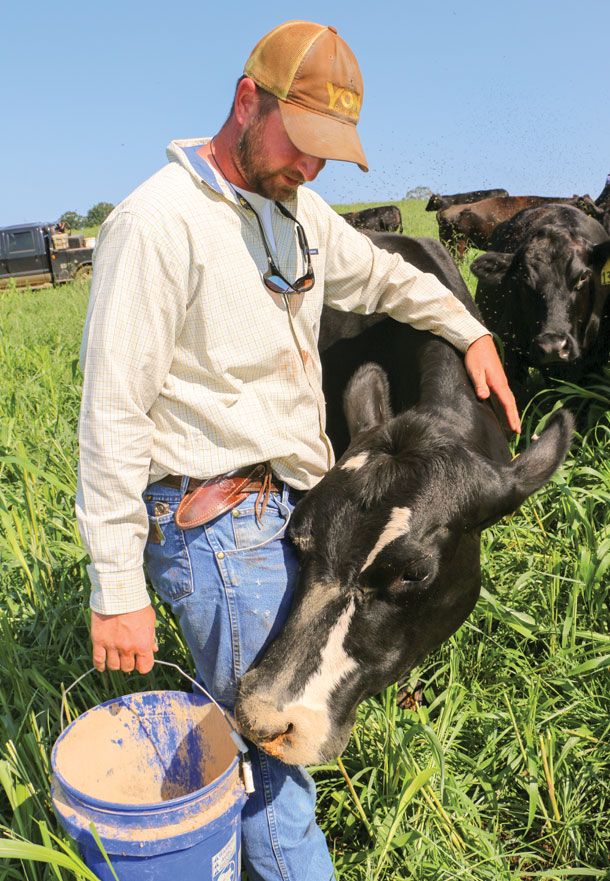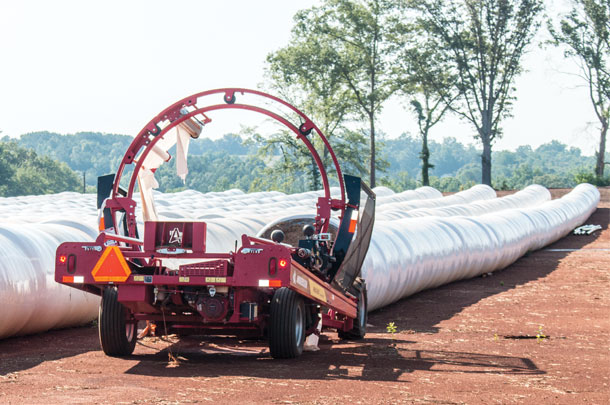As you drive by, you will see bare land that has been cleared to accommodate a six-tower irrigation pivot. The pivot is a direct result of 95,000 linear feet of streams, all fenced, which are now part of 641 acres in a conservation easement mitigation bank.
Owner Gary Alexander says, “The long-term yield will be far greater than any crop or any cow we could ever put on it. The credit value of the land and the set-aside value of the land being preserved, the value of that credit is the long-term benefit.”

Under the program, the landowner maintains ownership of the land and preserves the clean water, but the actual credit is worth more than having cleared the area to run cattle on it or farm it.
But it wasn’t easy creating all of the mitigation banks for the streams and getting approvals. Gary says, “We spent 42 months of our life holding hands with an engineering group and the Corps of Engineers.
But once we understood the mitigation process, we took a dozer and GPS and went around to all these delineated streams and said, ‘Do we want to farm what’s right on that stream or move up the hill a little bit and give a strip to the corps?’” In the process, a mitigation bank was set up, and he essentially sells the credits.
Alexander says the mitigation bank program provides a great generational transition, as the cash flow the program creates adds a tremendous amount of value to the ongoing operation long term. He says, “So many farmers are reluctant to get into these easement situations because they don’t understand them.
But an easement, in our minds, is a management tool. And when you go to the mailbox and get a check that pays for the credits, it’s like a windfall amount from Heaven. And it’s better for everyone with the cattle out of those areas.”
“It’s had its pain,” Gary says. “It’s expensive; it’s had its moaning, groaning days. But, long-term, it’s a fantastic way to take land you’re not utilizing and produce income off of it and still be able to look out the back door and have pride in it.”
Gary’s original start didn’t come from the cattle business; it came from a poultry enterprise that still produces about 3 million birds a year. Those facilities have been modified and expanded over the years, but it wasn’t the ideal setup for growth. So Gary started looking around for a place to “build right” that would accommodate cattle growth and maintain stream quality. That led to conditioning the soils on new ground to support cattle.
Raising 3 million birds a year translates to production of about 3,200 tons of poultry litter. When his son, Clay, graduated from college, they bought additional ground from which Clay launched the beef enterprise. The newly cleared ground has benefited from initial poultry litter applications, but Clay says there is a limit to its benefit.
“We just realized we’ve been using litter because of convenience, but the grazing ground where the cows are now has enough potash and potassium in it, so we’re good on that and actually just shootin’ ourselves in the foot to continue to use litter,” he says. “We’ll transition now to selling some litter and only buying nitrogen back when we need it, and keep taking soil samples so we’ll know where we’re at.
The litter has done a fantastic job of getting the vegetation established.” Establishment of good pasture vegetation takes three to five years, Clay says.
Clay’s herd grazes new pastures seeded with crabgrass and bermudagrass. Most of the established pastures are crabgrass, bahia and bermudagrass. They also maintain a couple dedicated endophyte-free fescue pastures. His plan is to clear 100 to 150 acres a year to increase the pasture and expand the herd. Under the newly cleared pivot, he’ll plant a combination of wheat, oats and rye to chop in the spring and then plant a hybrid milo to chop twice in the summer.

But Clay’s focus for the herd is using A.I. He’s using predominantly Angus breeding for heifers but tries to get the cows back on a Sim-Angus breeding program. He says, “Our retained heifer we are loving the most is a Sim-Angus-cross cow bred with a Brangus bull, which gives us a little ear and some heat tolerance.
Our fall-calving window is late, so through June it’s really important our cows are still milking, and our Brangus cows will be out eating where our Angus cows are laid up in the shade.”
In selecting A.I. bulls for the heifers, Clay selects bulls with the goal of increasing weaning weights and yearling weights, as he doesn’t retain any calves out of heifers. For the cow herd, he focuses on bulls with good maternal genetics as he builds the herd.
He also highly values carcass yield. While all calves in previous years were sold through the local sale barn, he hopes to start backgrounding the calves and putting 100 pounds on them before selling them. One of his pastures with cows in it currently has some hybrid milo-sudangrass, and his intention is to pull the cows out and put the weaned calves back on the pasture, supplemented with a little cottonseed. The goal then is to market directly with buyers.
What started out as truly a fall-calving herd has migrated to a calving season currently from November through December. The migration happened as they tried to tighten the calving window. Clay says, “It’s cost a little – mid-summer calves won’t put on the weight spring calves do – but I don’t know but what the tightness of the calving window has offset that, but it’s definitely hurt the calves just a little bit.
Within two to three years, we hope to have a fall-calving and spring-calving group.” The cows currently calving in November and December naturally migrate about 20 days each year toward a spring-calving group. New heifers will be bred to create a fall-calving group. And his culling philosophy is pretty simple: no pay, no stay.
Future
Clay says, “In 10 years, I hope we are at our limits for cow herd numbers. We’ll have our feed established through our pivot running, and I hope we’re marketing a group of calves of our own and possibly some calves I can buy around here locally to be bought at weaning age and putting a couple hundred pounds on them and sending them on West.
When we get to a point where we’re not retaining all our own heifers, I would love to be able to say that I could put 100 quality bred commercial heifers on the market each year, just because I enjoy that so much. Through the beef and bred heifers, I want to continue with calf sales and what we’re doing and help it continue to grow.”
“Scratching a living out of the dirt” is what ranchers do. For Clay and Gary, that’s a literal description of their newly cleared ground, new pivot and pastures; it’s a shared dream. Sometimes you just have to start from scratch. ![]()
See more of the cattle operation in this slideshow.
PHOTO 1: The cow herd grazes crabgrass and bermudagrass-mixed grasses. During this wet spring, they had a difficult time keeping ahead of the pasture growth. Photo by Lynn Jaynes.
PHOTO 2: As part of the A.I. program, Clay Alexander says the Sim-Angus cows bred with a Brangus bull create cattle with heat tolerance that will continue to eat and milk well through the calves’ critical growing season. Photo by Lynn Jaynes.
PHOTO 3: Ryegrass grows well in the red South Carolina soil. Alexander’s herd grazes it in early spring, then he takes a cutting and wraps bales, and then the regrowth is grazed again. Photo by Carrie Veselka.

-
Lynn Jaynes
- Editor
- Progressive Dairyman
- Email Lynn Jaynes








